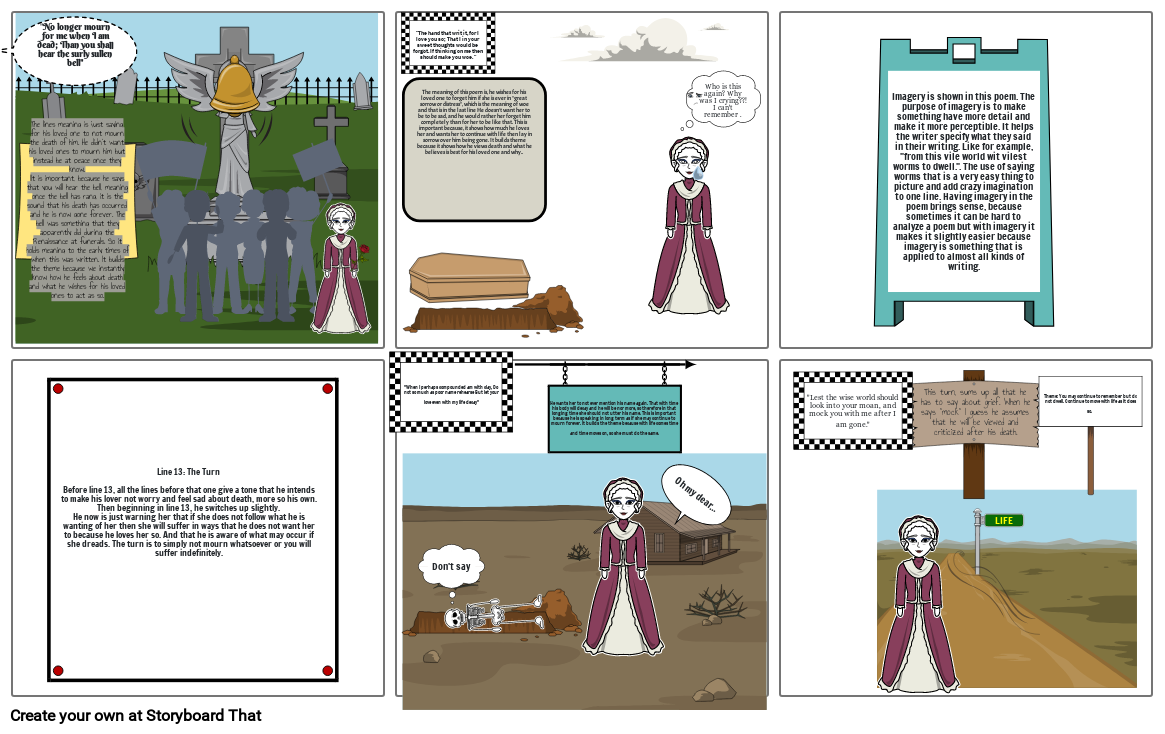Sonnet 71 by William Shakespeare

Storyboard Text
- "No longer mourn for me when I am dead; Than you shall hear the surly sullen bell"
- The lines meaning is just saying for his loved one to not mourn the death of him. He didn't want his loved ones to mourn him but instead be at peace once they know.IIt is important, because he says that you will hear the bell, meaning once the bell has rang, it is the sound that his death has occurred and he is now gone forever. The bell was something that they apparently did during the Renaissance at funerals. So it holds meaning to the early times of when this was written. It builds the theme because we instantly know how he feels about death and what he wishes for his loved ones to act as so.
- "The hand that writ it, for I love you so; That I in your sweet thoughts would be forgot. If thinking on me then should make you woe. "
- The meaning of this poem is, he wishes for his loved one to forget him if she is ever in "great sorrow or distress", which is the meaning of woe and that is in the last line He doesn't want her to be to be sad, and he would rather her forget him completely than for her to be like that. This is important because, it shows how much he loves her and wants her to continue with life then lay in sorrow over him being gone. It builds theme because it shows how he views death and what he believes is best for his loved one and why..
- Who is this again? Why was I crying??! I can't remember .
- Imagery is shown in this poem. The purpose of imagery is to make something have more detail and make it more perceptible. It helps the writer specify what they said in their writing. Like for example, "from this vile world wit vilest worms to dwell.". The use of saying worms that is a very easy thing to picture and add crazy imagination to one line. Having imagery in the poem brings sense, because sometimes it can be hard to analyze a poem but with imagery it makes it slightly easier because imagery is something that is applied to almost all kinds of writing.
- Line 13: The TurnBefore line 13, all the lines before that one give a tone that he intends to make his lover not worry and feel sad about death, more so his own. Then beginning in line 13, he switches up slightly. He now is just warning her that if she does not follow what he is wanting of her then she will suffer in ways that he does not want her to because he loves her so. And that he is aware of what may occur if she dreads. The turn is to simply not mourn whatsoever or you will suffer indefinitely.
- "When I perhaps compounded am with clay, Do not so much as poor name rehearse But let your love even with my life decay"
- Don't say
- He wants her to not ever mention his name again. That with time his body will decay and he will be nor more, so therefore in that longing time she should not utter his name. This is important because he is speaking in long term as if she may continue to mourn forever. It builds the theme because with life comes time and time moves on, so she must do the same.
- Oh my dear...
- "Lest the wise world should look into your moan, and mock you with me after I am gone."
- This turn, sums up all that he has to say about grief. When he says "mock" I guess he assumes that he will be viewed and criticized after his death.
- LIFE
- Theme: You may continue to remember but do not dwell. Continue to move with life as it does so.
Over 30 Million Storyboards Created
No Downloads, No Credit Card, and No Login Needed to Try!
